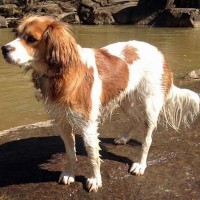Appearance of the Cava-Corgi
|
| The Cava-Corgi is generally quite small. It usually weighs no more than 6.5 kilos and measures around 30.5 centimetres at the shoulder. Of course, this will vary according to the Cava-Corgi's parent breeds. In addition, the female tends to be slightly larger than her male counterpart. Her hair will generally be of medium to long length. Occasionally, it can be wavy or curly. It can have a variety of colors, but often will be modeled much like the parent Cavalier King Charles Spaniel breed. It can be white with brown, red, fawn or lemon markings. It's also important to know the appearance of the Welsh Corgi Pembroke to determine what the Cava-Corgi might look like. The Welsh Corgi Pembroke is generally small-sized with a long body. The Cava-Corgi is probably a mixture of the two colors of the long-haired parent breed. It will probably have the short legs of its Corgi parent. |
Temperament of the Cava-Corgi
|
| The Cava-Corgi is a very gentle dog. It is happy and can bring family members together. He is certainly a companion dog. He loves his family and will want to be with you wherever you go. He is intelligent and one of the easiest breeds to train. He needs reinforcement with treats and other positive measures. He is known for obeying commands. He is excellent with children. He has a reputation for being playful and energetic with children, as well as being very affectionate. To understand the Cava-Corgi's personality, you need to know a little more about its parent breed, the Welsh Corgi Pembroke. The Corgi is a happy, loving and intelligent dog. However, they can be fiercely independent and training can be difficult. The Welsh Corgi Pembroke has also been known to nip at children's feet, their sheepdog instincts still strong. They have no intention of hurting anyone, simply bringing their charge back to where it belongs. The Corgi is also an excellent guard dog, so it's likely that your Cava-Corgi will be the same. It's a good dog for new owners. |
Needs and activities of the Cava-Corgi
|
| The Cava-Corgi is a playful little dog. However, it needs a minimum of thirty minutes of daily exercise to prevent it from having pent-up energy, which could lead it to be destructive. Dog parks are not recommended for the Cava-Corgi, he will certainly enjoy interaction with other dogs, but Cava-Corgis often tend to herd other animals or young children, so they should be kept on a leash unless in a fenced area. Perhaps he could accompany you on a walk or jog. Leaving your Cava-Corgi outside in an unfenced yard is not recommended, nor is leaving it unattended. It also has a reputation for chasing cars, so if you're outside with it, it should be on a leash or in a fenced-in area. |
Maintenance of the Cava-Corgi
|
| The Cava-Corgi has moderate grooming requirements. It's not difficult to care for, but grooming really depends on the type of coat it inherits. Generally speaking, the Cava-Corgi doesn't shed as much as its Cavalier King Charles Spaniel relative. It only needs a bath when it gets dirty. Use a soft bristle brush to remove tangles and mats. You may need to brush him two or three times a week during the moulting season. Brushing your dog's teeth two or three times a week will help prevent tooth decay and bad breath, but daily brushing is optimal for preventing gum disease. Trim your Cava-Corgi's nails at least every two weeks. As a general rule, if you hear your dog's nails clicking on the floor, it's time to trim them. It's important to start a grooming regime with your Cava-Corgi at an early age so he or she can get used to it. |









 English (United Kingdom)
English (United Kingdom)